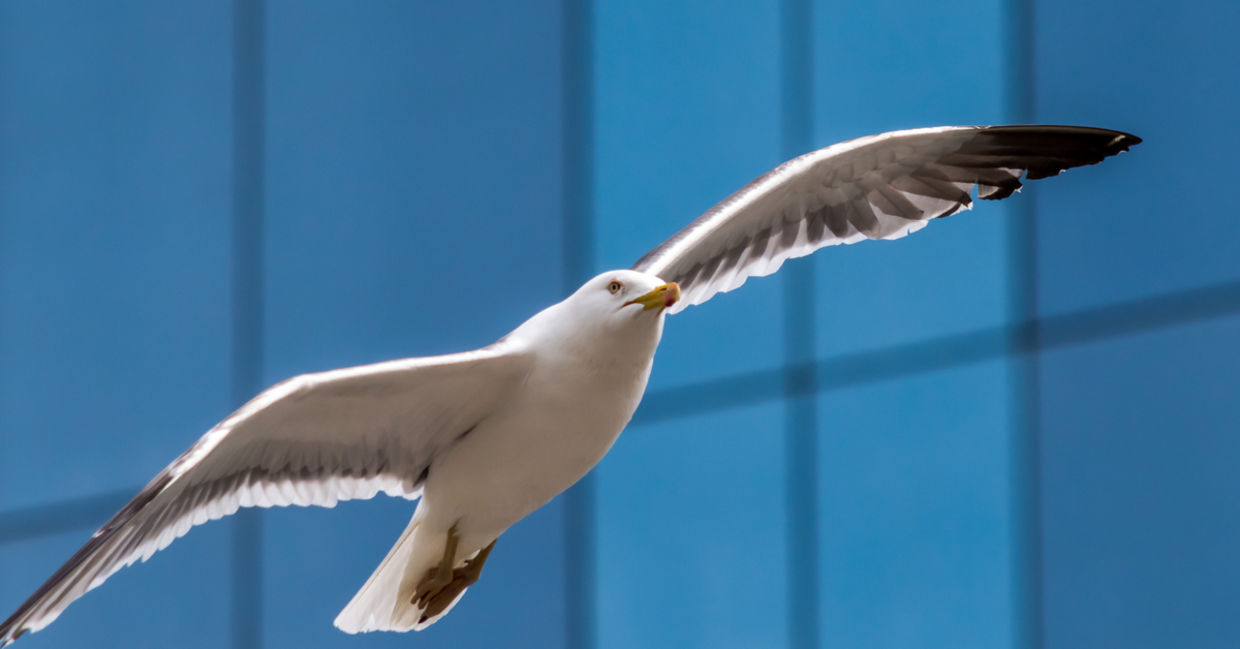
(Jacek Wojnarowski / Shutterstock.com)
Whether in Singapore, Tel Aviv, or New York, giant glass skyscrapers have become the defining feature of the urban skyline. Visually striking exteriors that reflect the clouds and nearly blend into the sky are now dominating design in cities across the world.
But while these buildings may be visually stunning, they are hazardous to winged animals. Tragically, the American Bird Conservancy reports that the deaths of some one billion birds each year can be directly linked to avian-unfriendly glass commonly used in skyscrapers.
Fortunately, Thomas Beatley says that cities can be made significantly more bird-friendly, via tweaks to existing structures that don’t require a complete design overhaul, and bird-safe building mandates for future projects. A professor of sustainable communities at the University of Virginia and the founder of the nonprofit organization Biophilic Cities, Beatley has long promoted urban planning strategies that benefit both the human and animal residents of cities.
Today!!!! Join us for a Free teleseminar about Cities that Love Nature with Timothy Beatley. He will share about what's happening with cities in connection with nature, the impact of the pandemic and the future of biophilic cities.https://t.co/8UIZNynO25 pic.twitter.com/JE59QFqNwx
— Nature Evolutionaries (@ONEearthrights) October 11, 2020
In his book The Bird-Friendly City: Creating Safe Urban Habitats, Beatley says that architects, urban planners, and developers must rethink the preference for buildings which use expansive clear glass. While these buildings are pleasing to the human eye and fit in with the predominant modern aesthetic, they are a major danger to birds.
“The idea that we are just throwing up buildings that have large expanses of clear glass — birds don’t recognize that as a barrier,” he told environmental news site Mongabay. “What they see when they look at glass is often the reflection of a tree or vegetation or a cloud. And so they have not evolved to avoid that hazard.”
Beatley explains that bird-safe glass, which uses dotted patterns that alert the bird to the presence of an obstacle, saves the lives of birds and provides urban spaces with a sleek, beautiful look. Cities including San Francisco and Toronto have already adopted mandates requiring new buildings to use bird-safe glass. Beatley believes that rather than try to convince individual building owners to revamp their properties with the new glass, cities should adopt policies that make bird-friendly design mandatory.
“We can work on a building-by-building basis to make them safer for birds, but a citywide mandate will bring these safeguards to scale quickly and have a much greater positive impact for birds,” Beatley told Fast Company. “Mandatory bird-safe design standards are very effective in reducing bird fatalities in cities, and there are now great model codes to look to and learn from.”
A common objection from architects and developers is that bird-friendly glass is more expensive than standard glass. But Beatley says that these extra costs are usually minor, and are often offset by benefits which lead to savings in the future, like reduced carbon emissions and lower energy consumption.
“The retrofit of the Jacob Javits Center in New York is a good example—the glass, which is fritted, or covered in tiny dots, has reduced bird mortality by more than 90% and also reduced energy consumption by 26%,” he said to Fast Company.
Aside from bird-friendly glass, Beatley explains that buildings can be designed to give nesting nooks to local birds. He also cites examples of cities that have created vertical gardens on the exteriors of skyscrapers, both making the skyline greener and providing an important source of food for bird populations.
Above all, Beatley believes that humans must stop placing stylish design over the wellbeing of animals. Urban design and planning should take the needs of local wildlife into account, and decisions must be made with environmental impact as a top priority. Cities must be spaces where both humans and other species can thrive.
“There are so many ways that we could be designing and planning with other species in mind, understanding that cities are these places where we want to see other life-forms,” Beatley said to Mongabay. “Our lives are richer and more meaningful for having those connections.”
With consciousness around environmentally-friendly practices growing, it’s time for cities to follow suit. As thought leaders like Beatley promote policies which ensure a better world for humans and animals alike, it's up to urban planners, architects, and municipalities to make choices that prioritize the welfare of all species.
YOU MIGHT ALSO LIKE:
Next-Gen Birdwatching: A Hobby That’s Poised to Take Off
Boutique Bird Hotels are Protecting the Arctic Kittiwake
Meet the Indian Man Taking Care of 4,000 Parakeets







